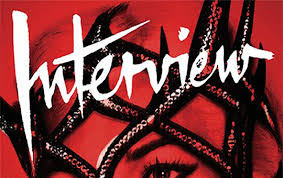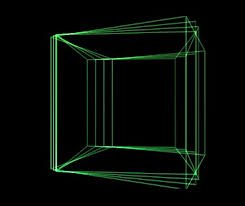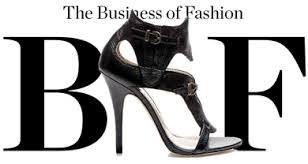Fall 06 RTW
For this collection, Alexander McQueen delved into his past, revisiting his Scottish family roots and refining the contents of the rampaging tartan "Highland Rape" show with which he began his career in London in the early nineties. Shorn of its original rawness and anger, the result was a poetic and technically accomplished tale that involved romantic images of Scottish fantasy heroines wandering glens and castle halls in vaguely Victorian tartan crinolines, bird-wing or antler-and-lace headdresses, feathered gowns, and pieces made from brocades that might have been dragged down from ancient wall-hangings.



Fall 06 RTW: Finale
Only Alexander McQueen could provide the astonishing feat of techno-magic that ended his show. Inside an empty glass pyramid, a mysterious puff of white smoke appeared from nowhere and spun in midair, slowly resolving itself into the moving, twisting shape of a woman enveloped in the billowing folds of a white dress. It was Kate Moss, her blonde hair and pale arms trailing in a dream-like apparition of fragility and beauty that danced for a few seconds, then shrank and dematerialized into the ether.
This vision was in fact a state-of-the-art hologram—a piece by the video maker Baillie Walsh, art-directed by McQueen. The gown, a pale cascade of multiple organza ruffles, wasn't just an optical effect, though. It subsequently reappeared in the collection's victory line up, which wound its way around the glass box as the audience was still reverberating with wonder at witnessing this incredible event.
Fall 08 RTW
The one element that has gone missing in the collections is the spine-tingling, eye-welling emotion of a show so exceptional to witness that—despite all exhaustion, cynicism, and workaday pressures—it suddenly transforms being involved in fashion into a magical privilege. Just when it seemed like that feeling was virtually extinct, Alexander McQueen handed his audience a self-imagined fantasy of crinolined princesses and British-colonial romance of such beauty, it arguably surpassed anything he's achieved in 14 years



Comments
"Oh! What a tantalizingly terrific tonic that was watching the Alexander McQueen show!!!
The most fantastic head dresses by Philip Tracey,the gracious and wonderful wooden peacock sitting there proudly on top the models head while ruffling and spreading its wooden tail,which resembled coral, in all its splendor so magnificently!"
"McQueen was fantastic, by the way, really gorgeous. Long live the McQueen! There were so many pieces to love. The colors were so vibrant, even the blacks. Every piece, stunning, not a weak look in the bunch. I’m just going to take your advice and forget the historical references, something about the English in India, British Empire, India Empire, I thought of Kipling’s novel “Kim,” immediately. But you know, there is an honesty in that kind of approach and inspiration. It wasn’t trying to come from the point of view of someone from India or someone who has lived in India a long-time as an ex-pat. The references didn’t matter, the collection became it’s own whole. The lines, as you said, were clean, or rather, lean, such a lightness to it, yet, so luxurious, such depth, from the constructions, to the silhouettes, to the colors and fabrics. Furthermore, there was no feeling he was all over the place. He gave us a strong point of view on hemlines on the dresses, etc. He didn’t throw everything but the kitchen sink at us. I felt like I could have a conversation with these clothes, and they would talk back! For ready-to-wear, it had a very couture feel. I didn’t feel I was being zapped by Zeus-like lightening bolts with the McQueen, there was no heavy-handedness here, very Empire-light, very relevant in an age of constitutional monarchy. Royals are to be beheld, admired, but not obeyed, ha."
"What a feast Lee Mc Queen presented to our eyes! The presentation, after watching the mining and redux of other labels and houses (how many more bastardizations can Lagerfeld concoct at Chanel?) was a thrill and a high soooo worth waiting for!"
"McQueen was superb, really. The first looks reminded me Gareth Pugh - and I got scared. But then I could notice Mr McQueen's terrific signatures. Very good work. Dazzling effects.
P.S.: Can anyone look at Mr Mcqueen’s shows without thinking about couture? It’s very intriguing, because despite the haute couture touches (and techniques, I guess) the clothing has a singular contemporary air… I’m still looking for this question."
"McQueen is the only Queen that matters! Go Alex, go!"
"I agree with you on Chanel… it’s a mystery to me why season after season the press praises Lagerfeld.
McQueen would be a great replacement."
[pics: (style.com) (images.google.com)]
[reviews: Sarah Mower @ style.com]
Best Collections - 1
Best Collections - 2
Best Collections - 3
Best Collections - 4
Best Collections - 5
AlexanderMcQueen.com - Catwalk Archive
Deconstruction by Alexander McQueen
Alexander McQueen CBE (born Lee Alexander McQueen, 17 March 1969) is an English fashion designer.
Born in the East End of London, he is the son of a taxi driver.
McQueen started making dresses for his three sisters at a young age and announced his intention of becoming a fashion designer.
McQueen left Rokeby School at 16, landing himself an apprenticeship with Savile Row tailors Anderson & Sheppard, then working for Gieves & Hawkes and the famous theatrical costumiers Angels and Bermans. Whilst on Savile Row, McQueen's clients included Mikhail Gorbachev and Charles, Prince of Wales. At the age of 20, he spent a period of time working for Koji Tatsuno before traveling to Milan, Italy and working for Romeo Gigli.
McQueen returned to London in 1994 and applied to London's most prestigious fashion school, Central Saint Martins College of Art and Design to work as a pattern cutter tutor. Due to the strength of his portfolio he was persuaded by the Head of the Masters course to enroll on the course as a student. He received his Masters Degree in Fashion design and famously, his graduation collection was bought in its entirety by influential fashion stylist Isabella Blow, who was said to have persuaded McQueen to change his name from Lee to Alexander (his middle name) when he subsequently launched his fashion career.
Alexander McQueen's early runway collections developed his reputation for controversy and shock tactics (earning the title "enfant terrible" and "the hooligan of English fashion"), with trousers aptly named "bumsters", and a collection entitled "Highland Rape". It has also been claimed that he was on income support and that he needed to change his name for his first show so that he could continue to receive benefits. McQueen is known for his lavish, unconventional runway shows, such as a recreation of a shipwreck for his spring 2003 collection, spring 2005’s human chess game and his fall 2006 show, "Widows of Culloden", which featured a life-sized hologram of supermodel Kate Moss, dressed in yards of rippling fabric.
The president of LVMH, Bernard Arnault caused a stir when he instated McQueen as head designer at Givenchy in 1996, succeeding John Galliano. Upon arrival at Givenchy, McQueen insulted the founder by calling him ‘irrelevant’. Thus, his first couture collection with Givenchy was unsucessful, with even McQueen telling Vogue in October 1997 that the collection was “crap”. McQueen toned down his act at Givenchy, but continued to indulge his rebellious streak, causing controversy in Autumn 1998 with a show which included car-robots spraying paint over white cotton dresses, and double amputee model Aimee Mullins striding down the catwalk on intricately carved wooden legs. McQueen stayed with Givenchy until March 2001, when the contract he said was "constraining his creativity" was ended.
Some of Alexander McQueen's accomplishments include being one of the youngest designers to achieve the title "British Designer of the Year", which he won three times between 1996 and 2003. He has also been awarded the CBE (Commander of the British Empire), as well as being named International Designer of the Year at the Council of Fashion Designer Awards. December 2000 saw a new partnership for McQueen with Gucci Group acquiring 51% of the company, and McQueen serving as Creative Director. Plans for expansion have included the opening of stores in London, Milan, and New York, and the launch of his perfumes Kingdom, and more recently My Queen. In 2005, McQueen collaborated with Puma to create a special line of trainers for the shoe brand.
Why We Love Fashion? It's Genius.
McQueen is a showman, and he has very high expectations for fashion. He knows how to cut a dress, a jacket and a pair of pants with the best of them, but that's not enough for him. He also wants fashion to have weight and content and depth, so he puts on presentations -- spectacles, really -- of his collections that aim to have the punch of art and that are sometimes political, sociological, shocking and scary. Some of this content carries over to the clothes themselves, either literally or in their aura. But in general their distinguishing features are beauty; a sense of craft; a strong, confident silhouette; and the marriage of tradition with the avant-garde. Even though he's a big believer in tradition when it comes to technique and tailoring, McQueen likes to goose the establishment, even to bite the hand that feeds him if his feathers are ruffled. (For example, his famously fractious tenure as the chief designer of Givenchy, which basically imploded amid much mudslinging in early 2001.)
It would appear that his is the classic story of the kid from the other side of the tracks making it big - and that's how fashion writers like to tell it. But McQueen's approach to fashion brings up the type of questions that surround genuine artists: where does his need to create come from, and what is it about fashion that's so important to him that he'll jump into the fire for it?
Sometimes when McQueen deals with loaded issues, like religious wars, class struggles or poverty and starvation, as he has in the past, he gets people hot and bothered. They object on all sides -- from those who think these subjects have no place in a fashion context, to those who believe that by introducing them on the runway they become glib and inappropriately glamorized. However, expecting McQueen to rid his work of worldly content would be like expecting Andy Warhol to go monochromatic.
Recently, I spent time with McQueen in London and talked to him about all of this. ''It's a personal point for me,'' he said. ''I believe in depicting what's going on. I'm a big anarchist. I don't believe in religion, or in another human being wanting to govern over someone else. The themes that go through my shows will continue to, because there's more to life. It's why I do what I do. I do believe fashion is a voice. And it's a voice that doesn't get heard that much in fashion apart from the work of someone like Rei Kawakubo. There are times when I'm less aggressive, but sometimes you have to shove it in someone's face.
I believe this now more than ever.''
When Bruno Bettelheim wrote his landmark study, ''The Uses of Enchantment: The Meaning and Importance of Fairy Tales,'' McQueen was just a small boy. But the designer's shows would be right up the psychiatrist's alley, for they are really often magical landscapes that exhibit a profound understanding of the importance of stories, of fairy tales and myths. Through his presentations, McQueen seems to intuit the various ways in which stories and fairy tales can liberate the emotions. Bettelheim wrote: ''For those who immerse themselves in what the fairy tale has to communicate, it becomes a deep, quiet pool which at first seems to reflect only our image; but behind it we soon discover the inner turmoils of our soul -- its depth, and ways to gain peace within ourselves and with the world, which is the reward of our struggles.''When McQueen picks up on fairy tales, he taps into their enchantment as well as the darkness and the underworlds so integral to them. His work is infused with ghosts, fears, loves, dreams, wishes -- all of it. His own life has been like one of the great fairy tales; it has lightness and cruelty, twists and turns. If written, this fairy tale would begin with a young boy of Scottish descent growing up in England and showing a passion for fashion by the age of 3. But as in all fairy tales, he has to travel through the dark side first. He is called ''McQueer'' in school, and his father expects him to become an electrician or a plumber like the rest of the lads, not the next Coco Chanel (who also came, as it happens, from a working-class background). Then one day his mother gives the boy a present that changes everything -- a book about people in fashion -- and it suggests to him that his dreams can come true. The next chapters of McQueen's life could have been written by the Brothers Grimm. He earns his way, working in environments worthy of Charles Dickens. Finally, the Cinderella moment happens. He strikes out on his own, and boom! Not only does he gain an instant following but within a few years he also gets to dance at the ball.
Two Madmen in Paris, Maybe Just a Little Bit Lost
Many fashion houses find it profitable to offer parallel realities: clothes made for the runway and the red carpet, and a second, modified group called the commercial line.
Though fashion journalists admit the importance of commercial lines, and even understand their increasing role in a global marketplace, they have a see-no-evil policy about them and feel a childlike sense of disappointment when such clothes pop up on a top designer’s runway. There is still the belief that a little stage madness can transcend everything.
For this reason alone, the collections of John Galliano and Alexander McQueen were noteworthy. They are true madmen of genius, and individually they have changed our notions about clothes. Mr. Galliano has also done a great deal for LVMH (Moët Hennessy Louis Vuitton) and its sister company, Dior, creating exciting fashion that made front-page news.
Maybe the explanation for this sedate mainstream turn is self-evident: Mr. Galliano has to try something different because his clothes aren’t generating the numbers the company wants. A designer doesn’t throw out a successful formula.
Mr. McQueen’s problem is different. His clothes were exquisite; you couldn’t take your eyes off them. Staged in the round Friday night at the Cirque d’ Hiver, with a chamber orchestra, the show opened with somber riding skirts and bird prints. The models’ faces were powdered to a ghostly white, their hair like birds’ nests.
The decadent, romantic pitch of the show was familiar. Still, it was fascinating to see how Mr. McQueen has refined his ideas. You thought, “This is madness,” as the outfits kept coming out, ending with a dress scattered with fresh autumn-tinted hydrangeas.
Yet in a way the collection wasn’t really about Handel’s “Sarabande,” as the press notes claimed, or the portraits of Goya or the Marchesa Luisa Casati. It was about the commercial line in the showroom. Those clothes may be pretty, but what is one supposed to comment on, exactly? The impression or the reality?























